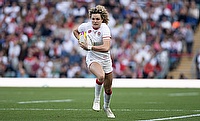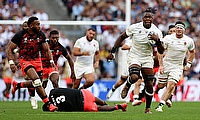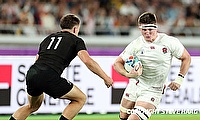Aviva Premiership EQP figures
As the salary cap rises in the Aviva Premiership, one pertinent worry for many has been that an influx of foreign players will follow and that the England national team will suffer as a result.
Others argue that the increase in the cap will simply allow Premiership clubs to bring in higher quality foreign imports, pushing them down a quality over quantity path, as well as ensuring they can retain their home-grown players.
It was reported last year that Premiership clubs were given an average target of 15 English-qualified players per matchday 23 to meet and that meeting that objective would be tied into the level of funding that the club receives from the RFU.
With three rounds of the season played, below are the average amounts of EQP players selected by each club so far this season.
1. Bath 19.3
T-2. Exeter Chiefs 18
T-2. Wasps 18
4. Leicester Tigers 17.3
5. Harlequins 16.7
6. Gloucester 16.3
7. Northampton Saints 16
8. Saracens 14.7
9. Sale Sharks 13.7
10. Bristol 13.3
T-11. Newcastle Falcons 12.7
T-11. Worcester Warriors 12.7
Over those three rounds, Bath (round two) and Harlequins (round three) fielded the most EQP players in a single match, with 20 members of their matchday 23s eligible for England. Bringing up the rear, Worcester (round one), Newcastle (round three) and Bristol (round three) fielded the least in a single match, with just 12 EQP members at various points during the opening weeks of the season.
As hinted by the averages, Bath, Exeter, Gloucester, Harlequins, Leicester, Northampton and Wasps have all met or surpassed the target in each game they’ve played so far this season. Bristol, Newcastle, Sale and Worcester, meanwhile, have yet to meet the target in any of their games so far, whilst Saracens have met the target twice and dipped under once (round three).
The numbers overall are certainly encouraging and lend weight to the second argument, that money has been spent on a smaller number of quality additions, as opposed to raiding the domestic tournaments in New Zealand, South Africa and Australia for a raft of new additions.
The numbers are helped by the productivity of the Premiership academies in recent years, with young players such as Harry Mallinder, Zach Mercer and Will Evans being trusted in the Premiership, where previously they would have been asked to serve apprenticeships in the Aviva A League or on dual-registration with a team in the Greene King IPA Championship.
Those average EQP figures should also be boosted when the Anglo-Welsh Cup returns, as Premiership directors of rugby will turn to members of their academies and give them playing time in the competition. It’s those games that the likes of Bristol, Newcastle, Sale and Worcester, all of whom are currently under that 15 EQP per 23 average, will need to ensure they bump up their numbers and they may need to field almost exclusively EQP 23s in order to meet the target, especially if they continue to field 12, 13 or 14 EQPs per game in the Premiership.
The salary cap will jump to £7m at the beginning of next season but will then hold steady for three straight seasons at that mark. It makes a lot of off-field sense, giving clubs time to ensure they are sustainable at the current mark before Premier Rugby Limited decide if a further increase is needed for the 2020/21 season. It should also maintain what currently looks to be a very healthy relationship between foreign imports and home-grown talent in competition.
The current club-country deal between PRL and RFU is well-balanced and both England and the Premiership look set to benefit from it. Any success Eddie Jones now has will be because of the system, rather than in spite of it, as were the conditions that many of his predecessors had to work with. Likewise, the Premiership clubs are suitably compensated for the loss of their England internationals, allowing them greater financial muscle to invest in their stadia, academy and club infrastructure.
We will continue to keep an eye on EQP numbers per team as the season goes on and bring to your attention any significant changes or noteworthy trends.








